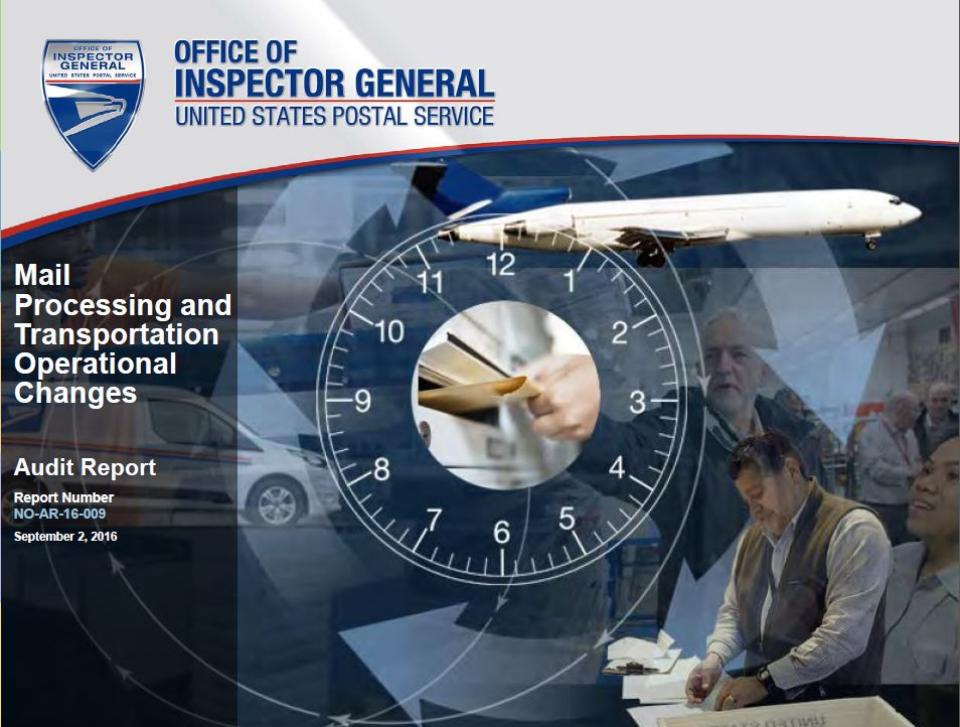Mail Processing and Transportation Operational Changes
Background
The Postal Accountability and Enhancement Act of 2006 noted the U.S. Postal Service had more facilities than it needed and should streamline its network to eliminate excess costs. The act requires the Postal Service to prepare a strategy for rationalizing its facilities network and remove excess processing capacity and space.
In 2011, the Postal Service announced its Network Rationalization Initiative (NRI) in response to its unsustainable financial situation. The purpose of NRI is to align the Postal Service’s network processing capacity with its declining mail volume through equipment and plant consolidations and operational changes.
As part of the NRI, on January 5, 2015, the Postal Service revised its First-Class Mail® service standards, eliminating single-piece overnight First-Class Mail service and shifting mail from a 2-day to a 3-day service standard. These revisions enabled the Postal Service to expand its mail processing operational window and this change is known as the operational window change (OWC). The Postal Service described the OWC as one of its most significant changes since automating mail processing. It was designed to allow the Postal Service to process mail on fewer machines, thus using less facility square footage.
The OWC was projected to save over $805 million annually through increased mail processing productivity, decreased premium pay, additional delivery point sequencing of mail, less mail sorting at fewer facilities, and use of more efficient mail sorting machines. The OWC also required changes in mail transportation.
Since implementing the OWC, stakeholders such as members of Congress, commercial mailers, and individual customers, have voiced concerns that delayed mail is increasing and service is declining.
The objective of this audit was to determine the timeliness of mail processing and transportation since the January 5, 2015, service standard revisions. In addition, we reviewed whether the projected cost savings from the OWC were realized.
What the OIG Found
For the 9 months following the January 5, 2015, service standard revisions, the Postal Service experienced increased nationwide delayed mail, reduced performance scores, decreased mail processing productivity, and increased transportation costs.
For the period January through September 2015, the Postal Service reported delayed mail processing increased by almost 638 million pieces (or 51 percent) compared to the same period in fiscal year (FY) 2014. Further, the Postal Service’s service standard measurements indicated that 2-day and 3-5 day First-Class Mail weekly performance scores declined by as much as 7 percent and 34 percent, respectively, compared to the same period a year earlier.
The Postal Service has taken significant steps to reduce delayed mail, notably deploying quick response teams based on Lean Six Sigma processes to determine causes and establish corrections.
Subsequently, the Postal Service reported delayed mail processing decreased by about a billion pieces (or 54 percent) for the period October 2015 through April 2016, compared to the same period in FY 2014. First-Class Mail service scores have significantly improved since the initial decline and are within about two percentage points of April 2014 service scores. Based on this improvement, we believe the Postal Service should not revert back to its prior operating window.
Although the Postal Service reported national delayed mail has been reduced significantly, it is still a problem for specific Processing and Distribution Centers serving certain urban and rural customers. In Quarters 1 and 2, FY 2016, the top 10 processing facilities with delayed mail had about 247 million pieces of delayed mail, or almost 30 percent of all delayed mail nationwide. These 10 facilities in CA, CO, IL, MD, PA, NJ, NY, and TX process mail for about 13.7 million delivery addresses.
In order to independently measure service after the OWC, we conducted a nationwide non-statistical mailing test of urban and rural areas from September through November 2015 and February through March 2016. We tested single piece First-Class Mail® letters, flats, and parcels and Priority Mail® flats and packages. Of the 2,995 pieces included in our test results, 27 percent (or 801 pieces) did not meet the service standards.
We found the increase in delayed mail and decrease in service scores was caused by three significant network and operational changes, insufficient air transportation capacity, mail arriving late at processing plants, outdated operating plans, and adverse winter weather.
In addition to service issues, the Postal Service did not achieve projected savings associated with the OWC. Management could provide support for achieving only 10 percent of the projected annual OWC savings presented to the Postal Regulatory Commission in 2011 of over $805.5 million.
The Postal Service stated there have been additional savings realized from the OWC separate from the projections presented to the Postal Regulatory Commission. The OIG validated $231 million additional savings.
However, the Postal Service exceeded its transportation budget plan by over $200 million (or 3 percent) in FY 2015. The Postal Service attributes $130.2 million of increased transportation costs to the OWC. About 1.7 billion more pieces of First-Class Mail (or 40 percent) were transported via contractor air transportation in 2015 than in the previous year due to changes in the critical entry time for this mail.
What the OIG Recommended
We recommended the vice president, Finance and Planning, re-evaluate the operational and transportation financial impacts associated with the OWC.
We recommended the vice president, Network Operations, develop and implement a nationwide strategy to improve mail processing productivity before implementing any additional nationwide operational changes or consolidations; increase air capacity to meet its critical entry times; create a nationwide system to track and report the amount, cause, and origin of mail arriving after its critical entry time; and establish a nationwide database to capture and share the Lean Six Sigma team’s lessons learned. In addition, we recommended instructing management to update all operating plans to reflect the OWC and continue monitoring and reducing delayed mail processing.

